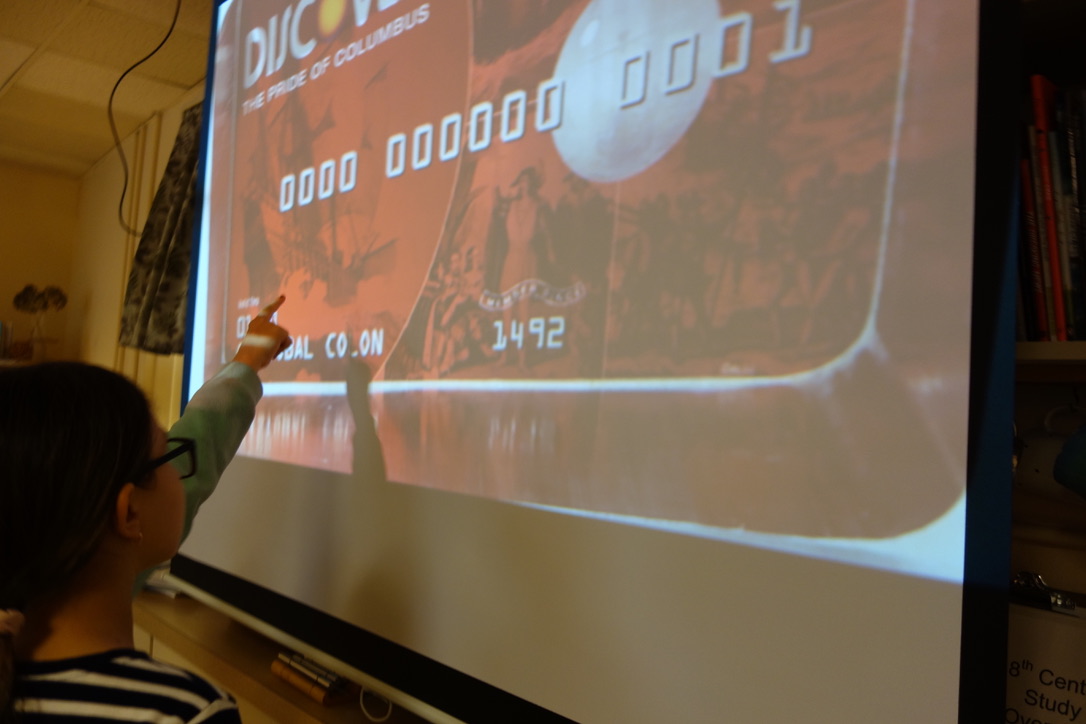How can we step out of our comfort zones to think critically about stories of injustice?

In the Willow Community of fourth- and fifth-graders this year, one big question we are chewing on is:
How might we raise a generation of citizens that know how to sustain a healthy democracy and a healthy planet?
We are exploring this question through the lens of American history as we pay attention to the interdependent social relationships that have sustained and continue to promote systems of injustice in our country.
We began thinking deeply and critically about how the story of Christopher Columbus and his explorations has been constructed. We explored different texts, engaged in dialogues and thinking protocols, and used the arts to deepen our thinking.
Nina’s wonderings after watching the Mel-o-Toons cartoon from 1960:
What would the native [peoples] think?
Is this all true?
Who is to blame?
What did they bring back?
“I read it before in third grade, but since we did a lot of social justice work last year, I saw it in a different way. I had more schema. -Emmerson
“Yeah! It made so much more sense!”
–Irene
Cottonwood (kindergarten/first-grade classroom) was reading The Invisible Boy. Nobody really wanted to talk to him. He was just alone. In Bill Bigelow’s article, they’re saying the Tainos are just invisible – [people] know the story of Columbus but not the Tainos. If Columbus was a penny and the Taino people were a dollar and the dollar gets ripped, then it just goes away but the penny stays.
-Sarah
As we explored these very different accounts of the “same” story, the children seemed to hold strongly to their first reactions. We brought this noticing to the group.
How do we respond to stories of injustice? Where do you go after your first reaction of blame and judgment?
Emmerson: That’s kind of how the human mind works: “Oh, that’s bad,” and a lot of other people agree. Then, it’s more certain that you’re going to agree on it. You don’t really have to look into it, you’re just like, “Oh, that’s bad”.
Laura: It’s kind of because Columbus is all we know and the Tainos are kind of like the ghost we’ve never seen or heard about. Columbus is the story and Tainos are the ghosts.
Emmy: Columbus sort of ghosted the Tainos and whenever we talk about the Tainos, we only know what happened before and after Columbus sailed and we know about the Taino when he encountered them but not other things.
As the children read more about the treatment of the Tainos, they were surprised when they read that the Taino’s “lives have been made invisible” and that their memory had been “erased from our nation’s classrooms.”
Guided by the following questions, the children used graphite to deepen their thinking.
How can you connect what lives inside of invisible to the relationship between history and the Taino people?
What does it mean to be invisible?
Invisible means erased or forgotten to me. The spirals are the Tainos and the graphite covering the spirals is Columbus. Columbus and the people who still celebrate him covered up the story of the Taino’s story over time.
-Michael, age 9
The white dot in the middle is the invisible thing/person being alone with no one paying attention to the person. They were just ignored. They used the Tainos as slaves and they did not pay attention to the Tainos and only thought about themselves but maybe some of the people worried about the Tainos but no one took a stance. Well, maybe some of them took a stance – but it was not strong enough to change the people of power’s minds.
-Polly, age 10
I think to the Tainos feeling invisible must be very hard because no one’s going to be able to hear their stories or their perspective because we are too busy to think and hear the Taino’s perspective.
-Leigh, age 10
Teachers’ Reflections
We noticed the initial reaction to many of these stories was one of surprise, blame, and judgment. We wondered how we move through these intense and uncomfortable emotions. What lives on the other side of these reactions? How do we move from feeling to action? What other histories and peoples can we uncover that may have been erased or are invisible? Who benefits from these stories?
This experience generated ideas to guide our next steps:
I wonder why did he kill the Tainos? Why do we worship Columbus if he didn’t set foot in the USA? -Laura
I don’t know what I believe he is. I wouldn’t be here without him. But he straight up tortured people. -Tyler
He went to a land and took people as a treasure – and people are not a treasure, they are a gift and a privilege. What and where would we be without him? -Emmy
Why do textbooks want him to be the good guy? -Todd
